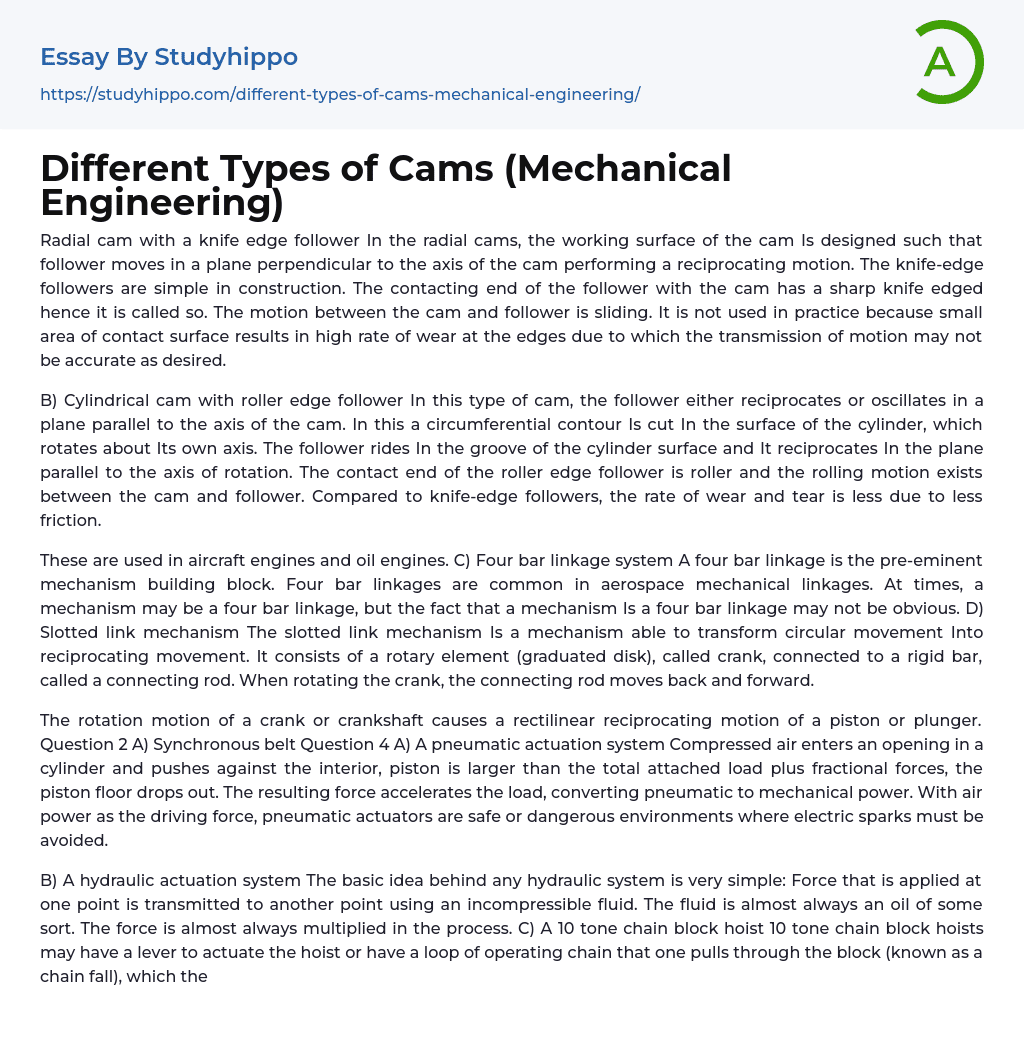Radial cam with a knife edge follower In the radial cams, the working surface of the cam Is designed such that follower moves in a plane perpendicular to the axis of the cam performing a reciprocating motion. The knife-edge followers are simple in construction. The contacting end of the follower with the cam has a sharp knife edged hence it is called so. The motion between the cam and follower is sliding. It is not used in practice because small area of contact surface results in high rate of wear at the edges due to which the transmission of motion may not be accurate as desired.
B) Cylindrical cam with roller edge follower In this type of cam, the follower either reciprocates or oscillates in a plane parallel to the axis of the cam. In this a cir
...cumferential contour Is cut In the surface of the cylinder, which rotates about Its own axis. The follower rides In the groove of the cylinder surface and It reciprocates In the plane parallel to the axis of rotation. The contact end of the roller edge follower is roller and the rolling motion exists between the cam and follower. Compared to knife-edge followers, the rate of wear and tear is less due to less friction.
These are used in aircraft engines and oil engines. C) Four bar linkage system A four bar linkage is the pre-eminent mechanism building block. Four bar linkages are common in aerospace mechanical linkages. At times, a mechanism may be a four bar linkage, but the fact that a mechanism Is a four bar linkage may not be obvious. D) Slotted link mechanism Th
slotted link mechanism Is a mechanism able to transform circular movement Into reciprocating movement. It consists of a rotary element (graduated disk), called crank, connected to a rigid bar, called a connecting rod. When rotating the crank, the connecting rod moves back and forward.
The rotation motion of a crank or crankshaft causes a rectilinear reciprocating motion of a piston or plunger. Question 2 A) Synchronous belt Question 4 A) A pneumatic actuation system Compressed air enters an opening in a cylinder and pushes against the interior, piston is larger than the total attached load plus fractional forces, the piston floor drops out. The resulting force accelerates the load, converting pneumatic to mechanical power. With air power as the driving force, pneumatic actuators are safe or dangerous environments where electric sparks must be avoided.
B) A hydraulic actuation system The basic idea behind any hydraulic system is very simple: Force that is applied at one point is transmitted to another point using an incompressible fluid. The fluid is almost always an oil of some sort. The force is almost always multiplied in the process. C) A 10 tone chain block hoist 10 tone chain block hoists may have a lever to actuate the hoist or have a loop of operating chain that one pulls through the block (known as a chain fall), which then activates the block to take up the main lifting chain.
- Auto Racing essays
- Classical Mechanics essays
- Harley-Davidson essays
- Rail Transport essays
- Suzuki essays
- Tata Motors essays
- trucks essays
- Vehicle Brands essays
- Administration essays
- Architect essays
- Discipline essays
- Doctor essays
- Engineer essays
- Farmer essays
- Hunter essays
- Labor essays
- Model essays
- Nurse essays
- Pilot essays
- Police Officer essays
- Professionalism essays
- Social Work essays
- Stakeholders essays
- Teamwork essays
- Automobile essays
- Bus essays
- Civil engineering essays
- Cycling essays
- Electric Car essays
- Genetic Engineering essays
- Hybrid essays
- Innovation essays
- Internal Combustion Engine essays
- Invention essays
- Mechanical Engineering essays
- Mechanics essays
- Software Engineering essays
- Telephone essays




